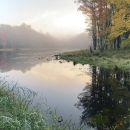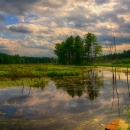About Us
Massasoit National Wildlife Refuge, established in 1983, is one of eight national wildlife refuges that comprise the Eastern Massachusetts National Wildlife Refuge Complex. Situated in Plymouth, Massachusetts, the refuge is part of the largest contiguous pitch pine scrub oak habitat area north of the Long Island Sound with 208 acres. This land, Patuxet (Plymouth) historically belonged to the Wampanoag Tribe.
The refuge supports the federally endangered northern red-bellied cooter as well as other wildlife that depend upon the unique kettle ponds, shorelines, and upland habitats. The refuge managed cooperatively with the Massachusetts Division of Fisheries and Wildlife and is closed to all public uses.
Our Mission
Vision
The Eastern Massachusetts National Wildlife Refuge Complex will contribute to the mission of the Refuge System and support ecosystem–wide priority wildlife and natural communities. Management will maximize the diversity and abundance of fish and wildlife with emphasis on threatened and endangered species, migratory birds, and aquatic resources. The Complex will have a well-funded and community supported acquisition program which contributes to wildlife conservation. The refuges will be well known nationally and appreciated in their communities. They will be seen as active partners in their communities, school systems, and environmental organizations which will result in high levels of support for the refuges. The refuges will be a showcase for sound wildlife management techniques and will offer top-quality, compatible, wildlife dependent recreational activities.
Refuge Purpose(s)
Each unit of the National Wildlife Refuge System is established to serve a statutory purpose that targets the conservation of native species dependent on its lands and waters. All activities on those acres are reviewed for compatibility with this statutory purpose.
Massasoit National Wildlife Refuge is one of more than 550 refuges of the U.S. Fish and Wildlife Service. It was established in 1983 to protect the Northern red-bellied cooter.
Our History
The Early Archaic Period (9,000 to 7,000 BP): Archaeological sites found in southeastern Massachusetts. The Wampanoag Tribe has inhabited southeastern Massachusetts, the Cape, and Islands for over 12,000 years. In Patuxet (Plymouth), the Tribe used the coastal environment in the warmer months for gardening and fishing and moved inland for the harsher winter months. Check here for more history on the Wampanoag Tribe.
1620: The pilgrims settle in Plymouth Massachusetts
1983: Refuge is Established
Other Facilities in this Complex
Situated along the Atlantic Flyway in Massachusetts, the Eastern Massachusetts National Wildlife Refuge Complex is comprised of eight ecologically diverse refuges. The eight individual refuges include inland and coastal wetlands, forests, grasslands, and barrier beaches that provide important habitat for migratory birds, mammals, plants, reptiles and amphibians.
Complex headquarters is located at Great Meadows National Wildlife Refuge, 73 Weir Hill Road, Sudbury, Massachusetts, 01776. Phone: (978) 443-4661, Fax: (978) 443-2898.



